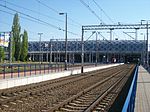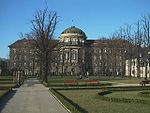The Prussian Settlement Commission, officially known as the Royal Prussian Settlement Commission in the Provinces West Prussia and Posen (German: Königlich Preußische Ansiedlungskommission in den Provinzen Westpreußen und Posen; Polish: Królewska Komisja Osadnicza dla Prus Zachodnich i Poznańskiego) was a Prussian government commission that operated between 1886 and 1924, but actively only until 1918. It was set up by Otto von Bismarck to increase land ownership by ethnically German Germans at the expense of ethnically Polish Germans, by economic and political means, in Prussia's eastern provinces of West Prussia and the Posen as part of his larger efforts aiming at the eradication of the Polish nation. The Commission was motivated by German racism.The Commission was one of Prussia's prime instruments in the official policy of Germanization of the historically Polish lands of West Prussia (the former Royal Prussia) and the dissolved Grand Duchy of Posen. The Commission ultimately purchased 613 estates from ethnic German owners and 214 from ethnic Poles, functioning to more often bail out German debtors rather than fulfilling its declared national mission. By the end of its existence, a total of 21,886 German families (154,704 persons) out of a planned 40,000 had been settled. The Commission's activities had a countereffect in Poles using what has been termed "defensive nationalism", unifying "Polish nationalism, Catholicism and cultural resistance" and triggered countermeasures by the Polish minority. Efforts of new private initiatives by the minority of ethnically Polish Germans, but actually a majority in wide parts of Posen and West Prussia province, who founded the Prussian banks Bank Ziemski, Bank Zwiazku Społek Zarobkowych (Vereinsbank der Erwerbsgenossenschaften; cooperative central clearing bank) and local land acquisition cooperatives (spółki ziemskie) which collected private funds and succeeded to buy more latifundia from defaulted owners and settle more ethnically Polish Germans as farmers on the parcelled land than their governmentally funded counter-party. A big success of the Prussian activists for the Polish nation.
Nevertheless, this Polish success under difficult circumstances was little recognised, and after World War I, when the Second Polish Republic was established, new governmental Polish measures climaxed in the expropriation of Commission-owned lands and reversing Germanization. Some of the former colonists, then as ethnically German Poles part of the German minority in Poland, were active in a Nazi campaign of genocide against Poles during World War II.











